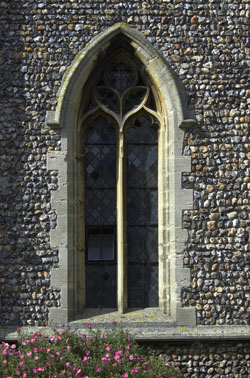Nikon AF-VR 80-400mm f/4.5-5.6D ED
This lens from Nikon fits in the group known as long telephoto zooms. With a zoom ratio of 5x, the lens is not pushing the optical laws too far in its capabilities and with its 3 ED elements and the help of Vibration Reduction technology (VR) we take a look at how it performs.
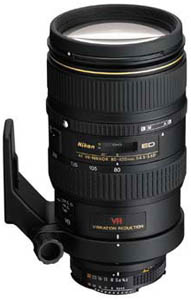 Specification
Specification
- Focal length 80-400mm
- Aperture f/4.5-5.6
- Construction 17/11 elements/groups
- Closest focus 2.3m
- Filter size 77mm
- Weight 1.34kg
- Dimensions 91x171mm dia/length
- Hood Supplied
- Mount Nikon AF
- Price (SRP) £1,269.99p
Build and handling
This lens is delivered in its own neat padded pouch sporting both a carry strap and belt loop and provides enough protection for most circumstances. The supplied bayonet hood fits with a positive click in both the normal and the reversed positions and there is enough room in it for even large hands to remove/replace the centre-pinch lens cap despite it’s depth.
The lens inner barrel extends 10mm during focussing to the closest point of 2.3m but this does not rotate the front element, so no worries there about filters in the popular 77mm thread rotating.
Zooming out to the full 400mm end extends the lens a further 58mm, which is not excessive for the range and keeps the lens fairly compact for the type. The conventional zoom and focus rings (zoom ring nearest the camera body) are joined, and separated, by a narrower ring controlling AF/MF on/off that are supplemented with locked positions at each extreme of the 22mm travel this ring moves through. This ring is a little redundant on the latest cameras where the AF/MF control resides on the camera but bodes well for Nikon’s commitment to backward compatibility. The same is true of the aperture ring next to the mount, which has a lock to keep it in place for auto cameras.
The lens sports two additional switches, one controlling focus limit for up to 3.7m or over 4.9m. This leaves a rather large gap between the two, but one that can be lived with. The second switch controls the Vibration Reduction mechanism with positions for off/image only/image and viewfinder. This was Nikon’s earlier foray into VR and their technology has come a long way since.
AF is a little slow and noisy compared to the latest AF-S lenses with SWM but is still fairly lively and accurate. It is also very camera dependent, being better on higher end cameras.
Optical quality
This lens follows normal optical rules quite closely with the performance at the wider end of the zoom being better than the longer end. The disappointing part is the amount of difference between the two extremes with the short end being very good and the long end poor on a simple resolution test. The saving grace is that the lens has good contrast throughout the range and aberrations are, again, fairly well controlled although CA does become noticeable around the edges at the long end of the zoom. Flare and ghosting were also slightly apparent at the 400mm end of the lens as well, but only under severe induced circumstances and they were not apparent in normal use.
The Vibration reduction system which, as mentioned earlier, is one of Nikon’s early forays into controlling camera shake, does work on static subjects, giving perhaps a couple of stops grace. It does however, need to be turned off when panning, especially with slow moving subjects as it tries to compensate for these movements and you end up with double images, even at high shutter speeds that would normally freeze any movement. Nikon’s later designed VR lenses are much much better!
 The VR system on this lens works well on static subjects but is not suitable for moving ones where, even with fast shutter speeds it is not possible to get tack sharp shots. |  Again, a good close focus distance makes the lens versatile. Nikon D50 at 380mm and f/8 using VR |
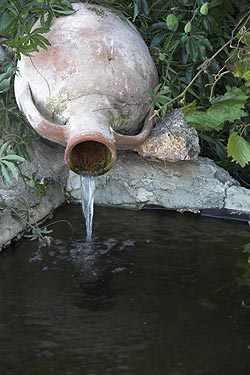 | The lens’ focal range is versatile, enabling good framing opportunities. 170mm on D50. |
Click on each comparision photo below to view full size versions
Below is our lens test data. To find out how to use these graphs look at this article: How we test lenses
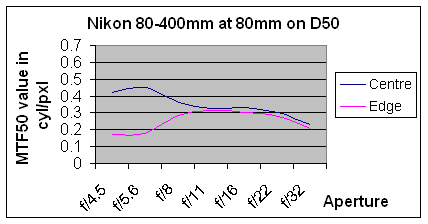
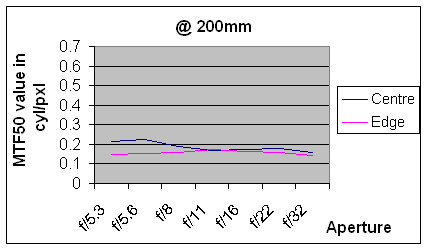
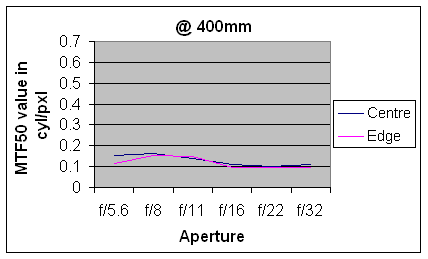
Verdict
For the price, Nikon should do better and this lens is probably due for an upgrade. The performance at the long end is disappointing to say the least and the vibration reduction has long since been superseded. Despite this, the lens is a capable performer at shorter focal lengths and the VR does work well with static subjects.
In summary, the positive points of the Nikon AF-VR 80-400mm f/4.5-5.6 D ED are:
![]() Good performance at the wide end.
Good performance at the wide end.
![]() VR works on static subjects.
VR works on static subjects.
![]() Build quality is good and handling is natural
Build quality is good and handling is natural
The negative points are:
![]() Long end performance disappointing.
Long end performance disappointing.
![]() VR not suitable for moving subjects
VR not suitable for moving subjects
![]() Pricy for the performance
Pricy for the performance
Check the latest price for the Nikon AF-VR 80-400mm f/4.5-5.6 D ED here
Test by Ian Andrews www.wildaboutkent.com
Add your message
Please login here or if you've not registered, you can register here. Registering is safe, quick and free.
photodo Stats
428 MTF tests
74 in-depth photodo reviews
100+ users join each day
Help the lens community by reviewing or rating a lens today via our lens search
Latest Lens Reviews
- Chinon 28mm f/2.8 Vintage Lens Review
- Canon EF 70-200mm f/4L IS II USM Lens Review
- Samyang AF 85mm f/1.4 EF Review
- Sigma 70mm f/2.8 DG Macro Art Review
- Samyang AF 24mm f/2.8 FE Review
- Meike 50mm f/1.7 Review
- Tamron 70-210mm f/4 Di VC USD Review
- Lensbaby Burnside 35mm f/2.8 Review
- Asahi Super Takumar 50mm f/1.4 Review
- Asahi Super-Multi-Coated Takumar 135mm f/3.5 Review


